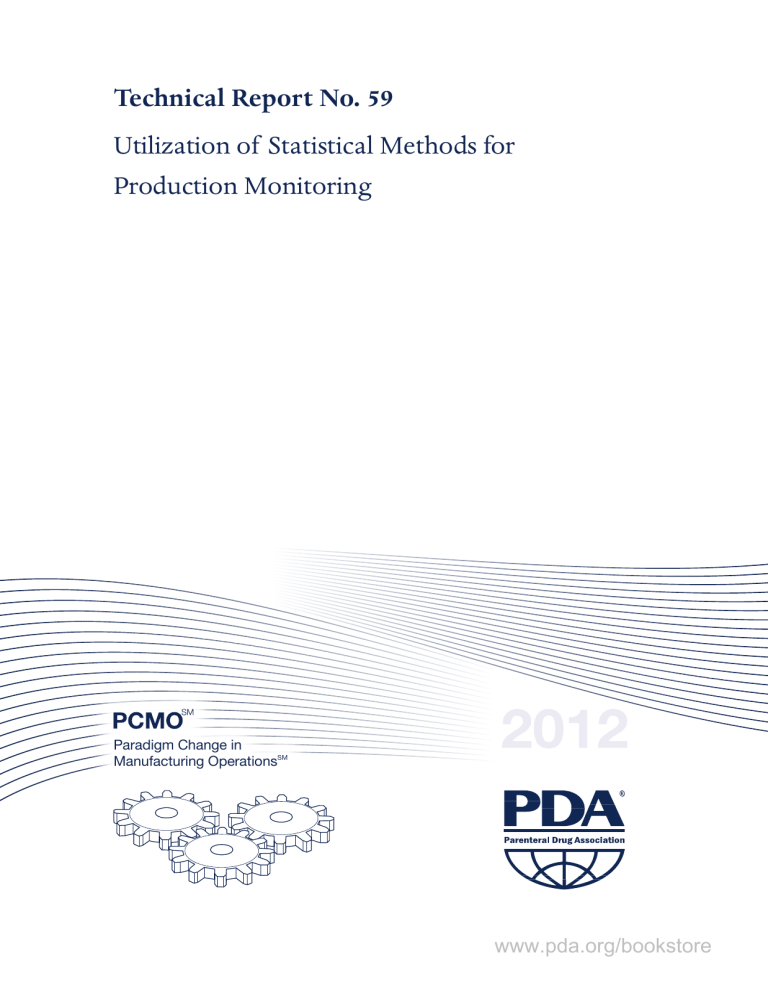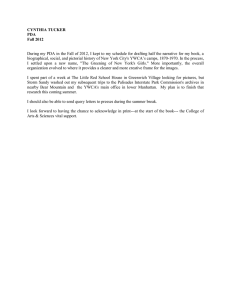Statistical Methods for Production Monitoring Technical Report
advertisement

Technical Report No. 59 Utilization of Statistical Methods for Production Monitoring Paradigm Change in Manufacturing OperationsSM Bethesda Towers 4350 East West Highway Suite 200 www.pda.org/bookstore Bethesda, MD 20814 USA Tel: 1 (301) 656-5900 PDA Utilization of Statistical Methods for Production Monitoring Task Force Members Authors Greg Flexman, Grifols (Chair) Stephan Rönninger, F. Hoffmann-La Roche Ltd. Michael Husovich, Amgen Mark A. Skoog, Genentech Jason J. Orloff, PharmStat Lynn D. Torbeck, PharmStat Jayesh Patel, F. Hoffmann-La Roche Inc. Dan Weese, Amgen This technical report was developed as a part of PDA’s Paradigm Change in Manufacturing Operation (PCMO) project. The content and views expressed in this Technical Report are the result of a consensus achieved by the authorizing Task Force and are not necessarily views of the organizations they represent. www.pda.org/bookstore Utilization of Statistical Methods for Production Monitoring Technical Report No. 59 ISBN: 978-0-939459-44-5 © 2012 Parenteral Drug Association, Inc. All rights reserved. Bethesda Towers 4350 East West Highway Suite 200 Bethesda, MD 20814 USA Tel: 1 (301) 656-5900 Fax: 1 (301) 986-0296 E-mail: info@pda.org Web site: www.pda.org www.pda.org/bookstore Paradigm Change in Manufacturing Operations (PCMOSM) PDA launched the project activities related to the PCMO program in December 2008 to help implement the scientific application of the ICH Q8, Q9 and Q10 series. The PDA Board of Directors approved this program in cooperation with the Regulatory Affairs and Quality Advisory Board, and the Biotechnology Advisory Board and Science Advisory Board of PDA. Although there are a number of acceptable pathways to address this concept, the PCMO program follows and covers the drug product lifecycle, employing the strategic theme of process robustness within the framework of the manufacturing operations. This project focuses on Pharmaceutical Quality Systems as an enabler of Quality Risk Management and Knowledge Management. Using the Parenteral Drug Association’s (PDA) membership expertise, the goal of the Paradigm Change in Manufacturing Operations Project is to drive the establishment of ‘best practice’ documents and /or training events in order to assist pharmaceutical manufacturers of Investigational Medicinal Products (IMPs) and commercial products in implementing the ICH guidelines on Pharmaceutical Development (ICH Q8, Q11), Quality Risk Management (ICH Q9) and Pharmaceutical Quality Systems (ICH Q10). The PCMO program facilitates communication among the experts from industry, university and regulators as well as experts from the respective ICH Expert Working Groups and Implementation Working Group. PCMO task force members also contribute to PDA conferences and workshops on the subject. PCMO follows the product lifecycle concept and has the following strategic intent: • Enable an innovative environment for continual improvement of products and systems • Integrate science and technology into manufacturing practice • Enhance manufacturing process robustness, risk based decision making and knowledge management • Foster communication among industry and regulatory authorities The Product Life Cycle Pharmaceutical Development Technology Transfer Commercial Manufacturing Product Discontinuation For more information, including the PCMO Dossi.e., and to get involved, go to www.pda.org/pcmo www.pda.org/bookstore Table of Contents 1.0 Introduction..........................................................1 4.0 Acceptance Sampling........................................24 1.1 Purpose and Scope........................................... 1 1.2 Implementation to Support Decision Making.... 1 4.1 Typical Applications....................................... 24 4.2 Key Terms....................................................... 24 4.2.1 Acceptable Quality Limit (AQL)................ 24 4.2.2 Rejectable Quality Level (RQL)................. 24 4.3 Types of Sampling.......................................... 25 4.3.1 Attributes Sampling................................. 25 4.3.2 Variable Sampling.................................... 25 4.4 Types of Acceptance Plans............................ 25 4.4.1 Single Sampling Plans............................. 25 4.4.2 Double Sampling Plans............................ 25 4.4.3 Individual Sampling Plan.......................... 25 4.4.4 Sampling Scheme.................................... 25 4.5 Pros and Cons................................................ 25 2.0 Glossary of Terms................................................2 3.0 Statistical Process Control Tools.........................8 3.0.1 Prerequisites for Data Analysis.................. 8 3.1 Run Charts...................................................... 11 3.1.1 Typical Applications................................. 12 3.1.2 Pros......................................................... 12 3.1.3 Cons........................................................ 12 3.2 Control Charts: Individuals.............................. 12 3.2.1 Attribute Control Charts........................... 12 3.2.2 Typical Applications................................. 13 3.2.3 Pros......................................................... 13 3.2.4 Cons........................................................ 13 3.3 Moving Range Control Charts......................... 13 3.3.1 Typical Applications................................. 13 3.3.2 Pros......................................................... 14 3.3.3 Cons........................................................ 14 3.4 Average and Variability Charts....................... 14 3.4.1 Typical Applications................................. 14 3.4.2 Pros......................................................... 14 3.4.3 Cons........................................................ 15 3.5 Histograms..................................................... 15 3.5.1 Typical Application.................................. 16 3.5.2 Pros......................................................... 16 3.5.3 Cons........................................................ 16 3.5.4 Distributions – Interpretation of Histograms.................... 16 3.5.5 Hints for Use............................................ 18 3.6 Process Capability (Cpk, Ppk)............................ 18 3.6.1 Assumptions........................................... 18 3.6.2 Typical Applications................................. 19 3.6.3 Pros......................................................... 20 3.6.4 Cons........................................................ 20 3.7 Exponentially Weighted Moving Average Charts .......................... 20 3.7.1 Typical Applications................................. 21 3.7.2 Pros......................................................... 21 3.7.3 Cons........................................................ 21 3.8 CuSum Charts................................................ 22 3.8.1 Process Features Suitable for This Type Method.................................... 22 3.8.2 Typical Applications................................. 22 3.8.3 Pros......................................................... 22 3.8.4 Cons........................................................ 23 3.9 Examples of Efficient Mixture of the Statistical Toolbox.......................................... 23 5.0 Appendices: Technical Details and Examples...27 5.1 Run Charts...................................................... 27 5.1.1 Technical Details...................................... 27 5.1.2 Example................................................... 27 5.2 Control Charts: Individuals.............................. 29 5.2.1 Technical Details...................................... 29 5.2.2 Example................................................... 30 5.3 Moving Range Control Charts......................... 33 5.3.1 Technical Details...................................... 33 5.3.2 Example................................................... 34 5.4 Average and Variability Charts....................... 37 5.4.1 Technical Details...................................... 37 5.4.2 Example................................................... 39 5.5 Histograms..................................................... 47 5.5.1 Example Case Worked in Parallel with Theory/Principles................. 47 5.6 Cpk, Ppk for Process Capability.......................... 48 5.6.1 General Procedure for Finding Cpk and Ppk................................... 48 5.6.2 Example Cpk for a Single Group................ 49 5.6.3 Cpk for Several Groups.............................. 50 5.6.4 Example 3, Ppk for Several Groups........... 52 5.7 Exponentially Weighted Moving Area Charts (EWMA)..................................... 52 5.7.1 Technical Details...................................... 52 5.7.2 Calculation Example................................ 53 5.7.3 Control Limits.......................................... 53 5.7.4 Example................................................... 54 5.7.4.1 Interpretation of Example................... 54 5.8 CuSum Charts................................................ 55 5.8.1 Example Calculation................................ 56 5.8.2 Details of Principles................................. 57 5.8.3 Interpretations Worked in Parallel with Theory/Principles..................................... 57 www.pda.org/bookstore 5.8.4 Implementation of CuSum Charts............ 59 5.8.5 Example: Gradual Trend .......................... 59 5.8.6 Preventative Action Before Failure Occurrence................................... 60 5.8.7 Example: For Process Optimization.......... 60 5.9 Sampling........................................................ 61 5.9.1 Example................................................... 61 6.0 References..........................................................63 7.0 Additional Reading..............................................64 FIGURES AND TABLES INDEX Figure 2.0- 1 Example of a High Capability (Low Variability) Process Capability Histogram............................................. 2 Figure 3.5.4-3 Bimodal Distribution........................... 17 Figure 3.5.4-4 Left Skewed Distribution.................... 18 Table 3.6.1-1 Significance of Cp............................... 19 Table 3.6.2-1 Interpretation of Cp Regarding Limits Taken....................... 20 Figure 3.7-1 Data Plot Compared to EWMA Chart.....21 Figure 3.8-1 Examples of an Unstable Process (Statistically Out Of Control)................. 4 Run Plot Compared to CuSum Chart of the Same Data...................... 22 Figure 3.9-1 Figure 2.0-5 Examples of Trends (Points Beyond Control Limits)...................................... 6 Example of a Tool Bar for Statistical Control of a Process........................... 23 Table 5.1.2-1 Lot Data by Manufacture date............ 27 Figure 2.0-6 Examples of Trends (Points within the control limits)....................... 6 Figure 5.1.2-1 Run Chart (Plot of Lot Data)................ 28 Table 3.0.1-1 Suggestions and Proposals on When to Use Statistical Tools .............. 9 Table 5.2.2-1 Table 3.0.1-2 Areas of Potential Implementation...... 10 Figure 3.1-1 Run Chart........................................... 11 Figure 2.0-2 Example of a Low Capability (High Variability) Process Capability Histogram............................................. 3 Figure 2.0-3 Examples of a Stable Process (Statistically In Control)........................ 4 Figure 2.0-4 Figure 3.2.1-1 Individual Control Chart...................... 12 Figure 5.1.2-2 Run Chart .......................................... 28 First 15 data points/ lots..................... 30 Figure 5.2.2-1 Run Chart (Plot of Lot Data)................ 30 Figure 5.2.2-2 Run Chart .......................................... 31 Table 5.2.2-2 Moving Range.................................... 32 Figure 5.2.2-3 Run Chart (UCL and LCL shown)........ 33 Figure 3.3-1 Moving Range Control Chart............... 13 Figure 3.4-1 Average and Range Chart................... 14 Table 5.3.2-1 Lot Data in Time Order........................ 34 Figure 3.5-1 Example of a typical Histogram Showing Data Location In Relation To Specification Limits........................ 15 Table 5.3.2-2 Lot Data with Moving Range.............. 35 Figure 5.3.2-1 MR Chart............................................ 35 Figure 3.5.4-1 Normal Distribution............................ 16 Figure 5.3.2-2 Moving Range Chart (Upper & Lower Limits Shown)......................... 36 Figure 3.5.4-2 Histogram of a Normal Distribution.... 17 Table 5.4.2-1 Sample Data Collection Table............. 40 www.pda.org/bookstore Table 5.4.2-2 Sample Average Data Collection Table.................................. 40 Figure 5.4.2-1 Sample X Chart................................... 41 Table 5.4.2-3 Sample Data Range Collection Table... 41 Figure 5.4.2-2 Sample Range Chart........................... 42 Table 5.4.2-4 Sample Data Average and Range Collection Table........................ 42 Figure 5.4.2-3 Sample Average X Chart.................... 43 Figure 5.4.2-4 Sample Range X Chart........................ 43 Figure 5.4.2-5 Sample Grand Range X Chart.............. 44 Table 5.6.2-1 Example of Cpk for a Single Group....... 49 Table 5.6.2-2 Example of 95% Confidence Interval for Cpk..................................... 50 Table 5.6.3-1 Cpk for Several Groups........................ 51 Table 5.6.3-2 For d2................................................. 51 Table 5.7.2-1 Step-Change Example (No process noise)............................. 53 Figure 5.7.4-1 Sample Random Distribution Plots..... 54 Figure 5.7.4.1-1 EWMA Plot (UCL & LCL).................... 55 Figure 5.4.2-6 Sample X Chart of Average Range on the Range........................... 44 Figure 5.8.1-1 Example Calculation........................... 56 Figure 5.4.2-7 Sample UCL and the LCL on the Range Chart........................................ 45 Figure 5.8.1-3 CuSum Chart with V-mask.................. 57 Figure 5.4.2-8 Sample UCL and the LCL on the Average Chart.................................... 46 Table 5.4.2-5 Sample Average and Range Data Table................................. 46 Figure 5.4.2-9 Sample Average and Range X Chart ....46 Figure 5.8.1-2 X-bar Chart vs. CuSum Chart.............. 56 Figure 5.8.3-1 CuSum Chart with Values Around 100.... 58 Figure. 5.8.3-2 CuSum Chart with a Slide Move at Event 50...................... 58 Figure. 5.8.3-3 CuSum Chart with an Upward Shift in Mean Between Points 23 to 50...... 58 Figure 5.4.2-10 Sample Average and Range X Chart (UCL & LCL)........................... 47 Figure 5.8.3-4 Example of a CuSum Chart................. 59 Figure 5.5.1-1 Sample Average and Range X Chart (UCL & LCL)........................................ 47 Figure 5.8.7-1 For process optimization.................... 60 Figure 5.5.1-2 Sample Statistical Distribution of Results........................................... 48 Figure 5.8.5-1 Gradual Trend..................................... 60 Table 5.9.1-1 Characteristics of Example Test Plan....62 Figure 5.9.1-1 OC Chart Curve................................... 62 www.pda.org/bookstore 1.0 Introduction As manufacturers seek to improve the quality of their goods, statistical methods have been rediscovered as vital tools for successful development and manufacturing. Industries like automotive, electronics, and consumer products grow and change partly as a result of adopting statistical methods. The pharmaceutical and biopharmaceutical industry increasingly recognizes the importance of statistical methods to consistently create products that conform to predetermined quality characteristics. Statistical methods provide objective evidence in meeting this goal and are fundamental for understanding the process, which enables further improvement and development. Industry and regulatory bodies are working together to provide guidance and frameworks on the use of statistical methods. The International Conference on Harmonisation, International Standards Organization and European Union have provided guidance on the use of statistical methods. In light of the increased focus on this topic, this PDA Task Force recognized the need to provide guidance to help companies identify and use statistical methods. The primary objective of this Task Force was to convey the appropriate use of statistical methods at a level most can understand. 1.1 Purpose and Scope The purpose of this document is to present relevant and easy-to-use statistical process control (SPC) methods that are applicable to the pharmaceutical/biopharmaceutical industry. Advanced statistical methods, such as multivariate models and Design of Experiment (DoE) will not be considered. An overview of acceptance sampling is also included in Section 4.0. 1.2 Implementation to Support Decision Making Statistical methods are intended to improve the quality of decision-making. They are simply a means to a result. If the manufacturer does not first understand why it is utilizing a statistical method, problems such as failing to detect important signals or over-detecting unimportant normal variation can occur. Caution should be exercised to first establish the question to be answered and then the statistical method to aid in answering the question. The statistical methods may be used in an ongoing program to analyze collected data. Timely evaluation of data allows the prompt detection of undesired process variation, which facilitates process understanding and may support responses to control variability. To best aid the end-user, each statistical method is described in the following format: • Description • Pros and Cons • Typical Applications • Technical Details and Examples (see appendices) The guidance contained in this document is not intended to establish mandatory standards for using statistical methods across a product’s lifecycle. www.pda.org/bookstore Technical Report No. 59 © 2012 Parenteral Drug Association, Inc. 1

